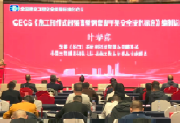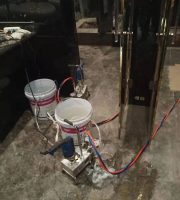Click “blue wechat name” under the title to quickly follow China formwork scaffold net | www.cnffww.com The official authoritative media of China formwork and scaffold Association focuses on serving formwork and scaffold enterprises with richer content and more powerful functions, helping upstream and downstream enterprises to connect easily, so that you can have all the information in your hand
. 
Pay close attention to us and get more service content
.
From Tencent video, Xinzhu classroom assembly building from production to construction of the whole process of graphic analysis assembly building is what? What are its advantages? How is prefabricated building produced? How is the site constructed? Let’s get to know
.
01
.
What is a prefabricated building? Like the tall building, prefabricated buildings will prefabricate some or all of the components in the factory, and then transport them to the construction site for assembly“ “Assembly” is not just “erection”
.
After the prefabricated components are transported to the construction site, the splicing and pouring of reinforced concrete will be carried out, so the assembly room is very safe
.
Therefore, this kind of “industrialized” and “industrialized” architecture has been widely used in Europe, America and Japan
.
First of all, on the external wall is this kind of lock type splicing method, and some are butted with steel skeleton
.
Then fill it, and finally add the sealing strip sealant
.
When building the interior wall, first install the skeleton, and then directly splice, which is convenient and fast, and also can facilitate the subsequent demolition
.
Compared with the traditional way of construction, prefabricated building is not only more convenient, but also can save manpower and materials
.
Therefore, it is not unreasonable for the state to promote prefabricated building
.
In the whole process of construction, these small prefabricated slabs are the most important
.
Although they look very simple, they need accurate data to ensure the success of splicing, so they need to be very careful in drawing
.
02
.
What are the advantages of prefabricated buildings? Why are these developed capitalist countries so keen on prefabricated buildings? The reasons are as follows: 1
.
To improve the construction quality, prefabricated components are prefabricated in the factory, which can maximally improve the common quality problems such as wall cracking and leakage, and improve the overall safety level, fire resistance and durability of the residence
.
2
.
It is beneficial to speed up the progress of the project, and the efficiency is the return
.
The progress of prefabricated building is about 30% faster than that of the traditional way
.
3
.
Hyaluronic acid, which is beneficial to improve the quality of construction, can make the construction products last forever
.
After the factory of interior decoration, it can realize the express delivery at home, that is, to dismantle and install, fast and good
.
4
.
It is conducive to adjusting the supply relationship, improving the listing speed of real estate, slowing down the current situation of insufficient supply in the market, so that there is no need to queue up all night to buy a house
.
After the popularization of the industry, it can reduce the construction cost and effectively restrain the house price
.
5
.
It is conducive to civilized construction and safety management
.
There are a large number of workers in the traditional operation site
.
Now, a large number of construction site operations are moved to the factory
.
Only a small number of workers need to be left on the site, which greatly reduces the incidence of on-site safety accidents
.
6
.
It is conducive to environmental protection and resource saving
.
There are few original cast-in-place operations on the site, and the health does not disturb the residents
.
In addition, the reuse rate of steel formwork is improved, and the waste, loss and energy saving can be reduced by more than half
.
03
.
How are fabricated components produced? Taking prefabricated building board as an example, the production process is: steel mold making → steel bar binding → concrete pouring → demoulding
.
Holes shall be reserved when binding reinforcement
.
The hook shall be embedded in the steel bar binding
.
Concrete pouring and assembly line operation
.
After demoulding, the finished fabricated plate and fabricated components are finished, which are temporarily classified and stacked in the factory, and then ready to be transported to the construction site
.
The finished assembled components are loaded on the road and transported to the site
.
04
.
The construction process takes the prefabricated frame structure as an example
.
After the construction of the first floor is completed, the columns of the upper floor are hoisted first, and then the main beam, secondary beam and floor are hoisted
.
After the hoisting of prefabricated components is completed, the steel bars at the connecting parts are bound, and the cast-in-place layer of nodes and beam slab is poured at last
.
What is the most technically demanding of the above steps? The answer is the hoisting of fabricated components
.
In order to ensure the smooth hoisting, after the prefabricated components are transported to the site, it is necessary to arrange the stacking site reasonably to facilitate the hoisting
.
Just like moving, we usually arrange the order of moving goods to reduce the workload reasonably
.
How to operate the most important hoisting step? The dressing mirror in the figure above is prepared for assembling column hoisting
.
The space in the lower part is narrow and it is not easy to observe
.
Through the reflection principle of the small dressing mirror, it is convenient to insert the reserved steel bar in the lower layer and the hole in the assembling column in the upper layer
.
Assembly type composite beam hoisting assembly type composite plate hoisting can also be pre assembled on site or build assembly type exhibition area for the parts with greater hoisting difficulty, which plays a demonstration role
.
After the pre assembly of the frame structure beam and the hoisting of the exhibition area of the shear wall residence, the steel bars of the cast-in-place layer are bound and ready to pour the concrete of the cast-in-place layer
.
In order to increase the connection between the fabricated components and the cast-in-place layer and ensure the reliability and safety of the structure, the surface of the fabricated components is left with keyway or rough treatment
.
There are many kinds of connection modes between prefabricated components
.
At present, the floor usually adopts the form of 7 + 8 (70mm thick precast floor + 80mm thick cast-in-place floor)
.
Taking the connection node of primary and secondary beams as an example, this paper shows the diversity of the connection methods between fabricated components: the connection edge node of primary and secondary beams – the node in the connection of primary and secondary beams with reserved notch of main beam – the connection node of primary and secondary beams in the reserved post pouring section of main beam – how can there be no mistakes in setting corbel of main beam? That is to number the fabricated components! In order to ensure that the workers will not make mistakes, reduce construction errors, and speed up the progress of the project, each component is given an ID card, which has its own unique ID number, so it is convenient to take a seat according to the number
.
Walls, slabs, stairs and other fabricated components have their own unique number
.
05
.
Cost control cost control and design management is the finishing point of the implementation process of prefabricated building
.
There are two important indicators of prefabricated building, the proportion of assembly area and prefabrication rate
.
Assembly rate = implemented assembly area ÷ Total surface area
.
Prefabrication rate = total volume of prefabricated components ÷ Total concrete volume
.
The higher the prefabrication rate, the higher the cost
.
According to the preliminary statistics, every 10% increase in prefabrication rate will result in a cost increment of about 150 yuan
.
Therefore, cost control is one of the key points in the implementation process of prefabricated building
.
First of all, the assembly range should be avoided in the first open area as far as possible
.
According to the requirements of assembly area in the transfer contract, the project cycle can be balanced through phased development
.
Because the prefabricated components need to cooperate with the factories in advance, and the capacity of these factories is limited, the time cost of the first phase development is under great pressure
.
Secondly, it is necessary to split the structural components and select the monomer with high repetition rate of prefabricated components
.
Generally, the repetition rate of components should be more than 100
.
The more repetitions, the better
.
How to split and select so many assembly components? a
.
The size of prefabricated components should follow the principle of less specifications / more combinations
.
b
.
The external protection components of the facade should be separated as a single bay as far as possible
.
c
.
The joint position of precast shear wall is selected at the place with less stress
.
d
.
When the component with larger length is split, it can be split symmetrically in the middle
.
e
.
Considering the influence of demoulding / stacking / transportation / hoisting on site, the weight of single member should be as close as possible, generally not more than 6T, the height should not span the floor height, and the length should not exceed 6m
.
Compared with the traditional cast-in-place building, the prefabricated house has higher requirements for the design and construction of each specialty, which needs the early participation of each specialty: a
.
the architectural specialty should consider the influence of facade style, thermal insulation form, floor area, stair surface method, embedded window frame, ceramic tile, stone back striking, etc.
.



